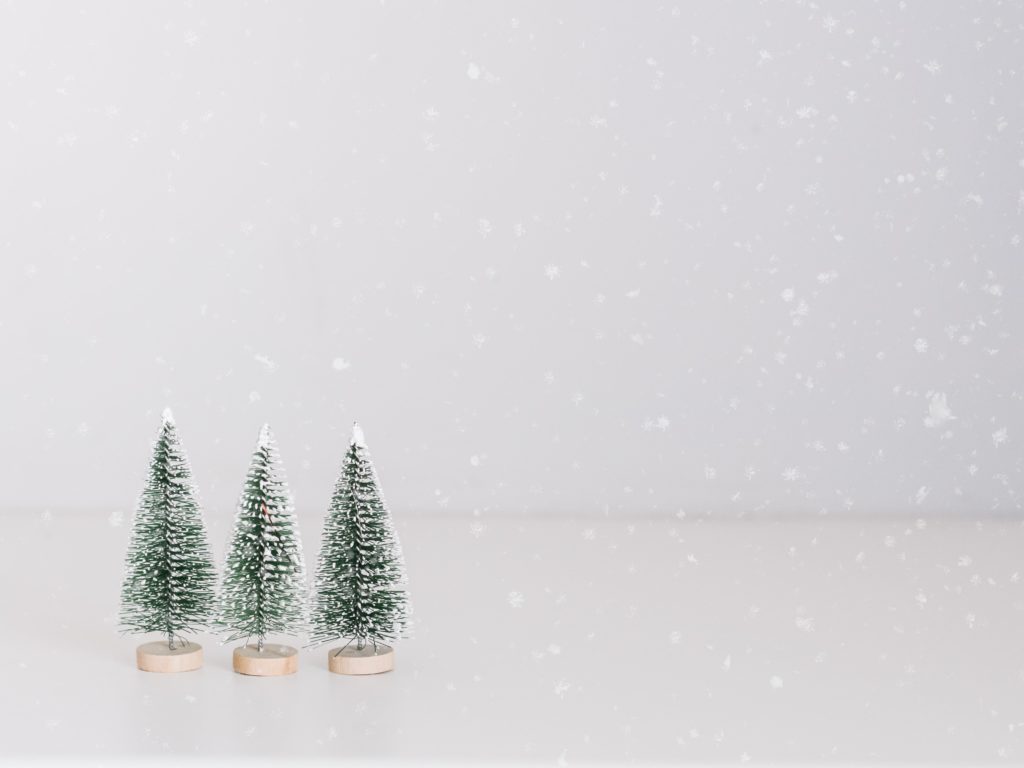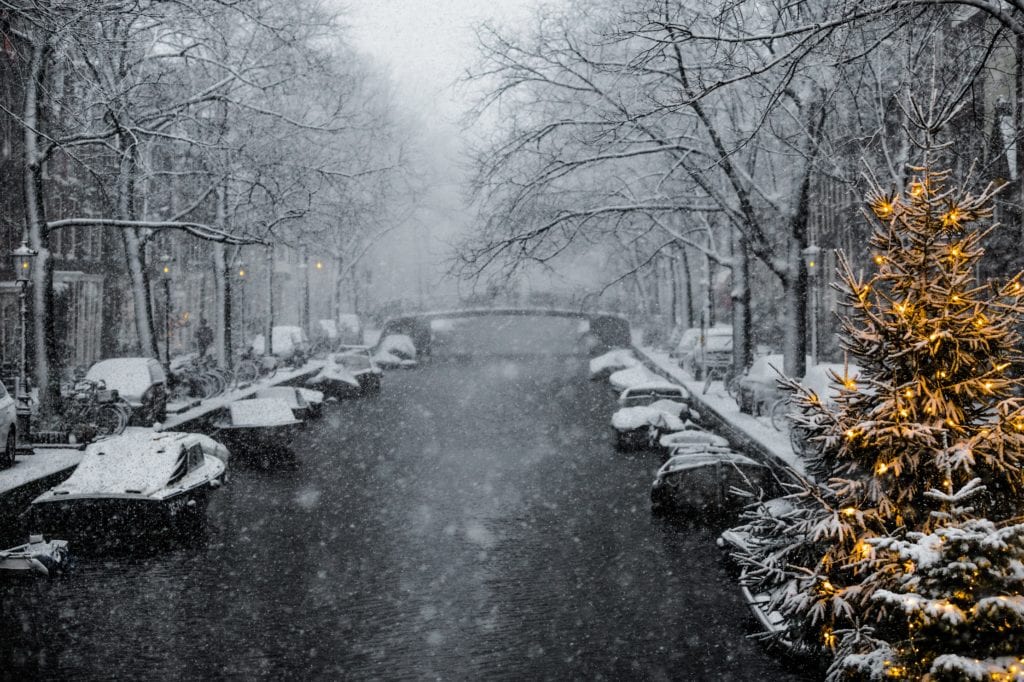Christmas Tree Graveyards
Every year when the Christmas excitement starts (which somehow seems to be earlier and earlier every year, but I’m not complaining) I start thinking about all the Christmas trees that one can see on the streets around New Year.
Quite literally; it looks like a Christmas tree graveyard as soon as the 24th, 25th, and 26th of December are over.
Not to be grim, but every time I see that I wonder: is it sustainable that these trees that often require 6 to 12 years to grow before being chopped and used as Christmas trees are also so quickly disposed of when the festive days are over?
All these millions of trees are wasted. It just seems a bit off.
Would it maybe be more sustainable to buy a good fake Christmas tree, that you could use for years and years instead of cutting down all these trees? Every. Year?
Great question! Let’s dive into it.
Real vs. Fake Christmas Trees
As our main Ecochain office is situated in Amsterdam, we’re going to take The Netherlands as an example here.
In the Netherlands, an average of 2,5 to 2,7 million real Christmas trees are sold and disposed of every year.
A real Christmas tree would be bought every year and thrown away afterward. A fake Christmas often has an average of 6 years of use from its buyers (At least this is the case for Northern America). This sounds more sustainable, so the fake Christmas tree wins.
Well…Not so quick. This is not the way to determine the sustainability of these trees.
To do so we need to look at their product life cycles. What does it take before you can even buy one of these trees?

One fake Christmas tree = 48 kg of CO₂-eq.
Performing a Life Cycle Assessment for a real tree means looking at all the steps between sowing the seeds and the final waste disposal (such as burning, landfills, or chopping).
Here we would look at aspects such as the use of energy sources in the life cycle, acidification of soil, carbon emissions, etc.
With regard to fake Christmas trees, this process is the same. We look at the environmental impact of all the lifecycle steps- from the mining of resources for plastic and metal to the trees’ final waste disposal.
To find the answers we dive into the research performed by Ellio. The fake Christmas tree they modeled was produced in- and chipped from China to Montreal, and used for 6 years. Their real tree is cultivated 150 km away from Montreal, and used for one year. Although this study is performed in Canada, it gives a good indication for Europe too.
They found that for a real tree, the biggest impact comes from the cultivation of the trees and transport to people’s homes. Its main impacts are on ecosystem quality. For fake Christmas trees, the biggest impact takes place during production and transport to the stores. Especially climate change and resource depletion are the biggest impact factors for fake Christmas Trees.
On average, the full carbon impact of the production of fake 2-meter tall Christmas trees shipped from China, lasting 6 years, is 48.3 kg of CO₂-eq (source: Ellio). Which is more than 16 times as large as that of a real tree that is afterward dropped in a landfill, or chipped, with a carbon footprint of 3,1 kg of CO₂-eq (source: Ellio).
But, the big ‘but’ is: can you compare the impact of a real tree that is bought every year, to a fake tree that is used multiple years?
If we divide the Christmas trees’ carbon impact over individual years, it’s about 3.1 kg CO₂ per year for the natural tree. And 8.1 kg CO₂ per year for the artificial tree (48.3 kg for its entire life span).
Are real trees better?
This answer really depends on how many times you use your fake Christmas tree.
If you use your fake Christmas tree for a minimum of 20 years you will also most likely have made up for the carbon emissions difference with real trees (this amount is still debated on though).
It basically comes down to this: buying a fake tree is more sustainable if you use it for as long as possible (approx. more than 20 years). Otherwise, a real tree is a more sustainable option.
Real trees don’t have the carbon emissions that fake trees need to be produced. In fact, real trees actually take in CO₂. Usually, this entails the intake of 2 tonnes of CO₂ per hectare of Christmas trees. So when a Christmas tree is burned, it emits the carbon dioxide that it stored up when it was growing. No net increase!
Moreover, one hectare of Christmas trees provides the necessary daily amount of oxygen for 44 people for as long as the trees live!
Next to the fact that Christmas trees also produce oxygen, they also filter other gasses such as methane or Ozon and filter the air of large amounts of particulate matter in the areas where they are grown.
Aren’t trees just great.
“ONE HECTARE OF CHRISTMAS TREES PROVIDES THE NECESSARY DAILY AMOUNT OF OXYGEN FOR 44 PEOPLE FOR AS LONG AS THE TREES LIVE”.

Keep or slightly adjust Christmas Tradition?
Farming trees is basically just like farming any other type of crop. They are cultivated (and recycled) for the pure purpose of consumption.
And if they are produced and recycled correctly, they do not have a large environmental impact.
Indeed, just with any other crop- they should be cultivated sustainably. And sustainable agriculture and biodiversity are important things that should be taken into consideration, also when it comes to Christmas trees.
So, if you want to act more sustainable, you can slightly adjust your Christmas Tradition by buying a sustainable and local Christmas tree and make sure to let the municipality (which is the case in The Netherlands) collect your Christmas trees afterward for proper recycling.
The best option? Buy a real potted tree and reuse it every year. That way it keeps taking in CO₂ and you prevent the cultivation of new trees. Or just don’t buy a Christmas tree at all ?
Sustainable Tree Initiatives
As people are becoming more and more conscious of even their Christmas Trees, many sustainable initiatives have popped up to make your Christmas become more sustainable.
First, if you want to buy a sustainable Christmas tree, you can always buy ones with a sustainable label on them.
In the Netherlands, these trees have the EKO Label or the MILIEUKEUR label. Many other countries have these labels as well. Just check them out!
Secondly, buy your Christmas tree from a local. By supporting your local Christmas tree producers you are cutting down on transport emissions and supporting local jobs and income.
Thirdly, you can now adopt a tree as well by buying/burrowing a potted tree. Potted trees can be replanted afterward and are, therefore, the most sustainable Christmas tree option.
Even better; if you need a new hobby and want to take on gardening, we suggest you could also grow your own Christmas tree in your backyard. Make it a cute Christmas tradition and watch it grow every year.
An eco-friendly Christmas
Buying a sustainable Christmas tree is of course not the only sustainable thing you can do during Christmas.
Support your locals, not only when it comes to Christmas trees, but also when it comes to food or presents/experiences for your loved ones.
You don’t have to change your Christmas traditions, just look at how you can make small changes by choosing different products or ways to celebrate. Every step is a step, just keep that in mind.


